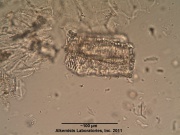|
|
| Line 1: |
Line 1: |
| | =Nomenclature= | | =Nomenclature= |
| | + | |
| | {{nomenclature | binomial=Hydrastis canadensis | | {{nomenclature | binomial=Hydrastis canadensis |
| | |authority=L. | | |authority=L. |
| Line 5: |
Line 6: |
| | |scn=goldenseal | | |scn=goldenseal |
| | |syn= | | |syn= |
| | + | |ayurvedic= |
| | + | |pinyin= |
| | |aka=yellow puccoon; yellow root | | |aka=yellow puccoon; yellow root |
| − | |notes=}} | + | |notes= }} |
| − | =Introduction=
| + | |
| − | ''Introduction from Wikipedia, the free encyclopedia (http://en.wikipedia.org/wiki/Hydrastis_canadensis, retrieved 02/27/2012).''
| + | |
| − | | + | |
| − | Goldenseal (Orange-root, Orangeroot; ''Hydrastis canadensis'') is a perennial herb in the buttercup family Ranunculaceae, native to southeastern Canada and the northeastern United States. It may be distinguished by its thick, yellow knotted rootstock. The stem is purplish and hairy above ground and yellow below ground where it connects to the yellow rhizome. The plant bears two palmate, hairy leaves with 5–7 double-toothed lobes and single, small, inconspicuous flowers with greenish white stamens in the late spring. It bears a single berry like a large raspberry with 10–30 seeds in the summer.
| + | |
| | | | |
| − | ''The quoted text in this section was licensed for use under the Creative Commons ShareAlike License, version 3.0: http://creativecommons.org/licenses/by-sa/3.0/''
| |
| | =Macroscopic Entries= | | =Macroscopic Entries= |
| | =Microscopic Entries= | | =Microscopic Entries= |
Revision as of 17:24, 14 March 2014
Nomenclature
Hydrastis canadensis L. Ranunculaceae
Standardized common name (English): goldenseal
Macroscopic Entries
Microscopic Entries
| Vessel element showing circular perforation from Hydrastis canadensis viewed at 400x with Acidified Chloral Hydrate.cellular structures identified in Hydrastis canadensis are the vessel element showing circular perforation and the orange brown granular mass when observed at 400x with Acidified Chloral Hydrate.
Source: Elan M. Sudberg, Alkemist Laboratories [1]
|
|
|
|
HPTLC Entries

Hydrastis canadensis HPTLC ID - Ninhydrin Reagent UV 365 nm
Golden Seal (root) (Hydrastis canadensis)
Lane Assignments Lanes, from left to right (Track, Volume, Sample):
- 5 μL Hydrastine ~0.1% in Methanol
- 3 μL Hydrastis canadensis-1 (root)
- 3 μL Hydrastis canadensis-2 (root)
- 3 μL Hydrastis canadensis-3 (root)
- 3 μL Hydrastis canadensis-3 (root)
- 3 μL Hydrastis canadensis-4 (root)
- 3 μL Hydrastis canadensis-5 (root)
- 1 μL Berberine chloride ~0.1% in Methanol
Reference materials used here have been authenticated by macroscopic, microscopic &/or TLC studies according to the reference source cited below held at Alkemists Laboratories, Costa Mesa, CA.
Stationary Phase Silica gel 60, F254, 10 x 10 cm HPTLC plates
Mobile Phase ethyl acetate: methanol: HCOOH: water [10/2/1.2/0.6]
Sample Preparation Method 0.25g+4 ml 80% MeOH snct 1/2 hr cntrfg/dcnt, add 2mL MeOH, vrtx&cntrfg,dcnt&qs to 20mL w MeOH
Detection Method Ninhydrin Reagent -> UV 365 nm
Reference see American Herbal Pharmacopoeia & Therapeutic Compendium
Source: Elan M. Sudberg, Alkemist Laboratories [2]
|
Other Points of Interest
Cite error: <ref> tags exist, but no <references/> tag was found


